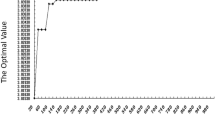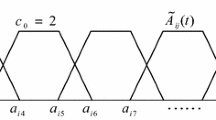Abstract
In order to solve three kinds of fuzzy programming models, i.e. fuzzy expected value model, fuzzy chance-constrained programming model, and fuzzy dependent-chance programming model, a simultaneous perturbation stochastic approximation algorithm is proposed by integrating neural network with fuzzy simulation. At first, fuzzy simulation is used to generate a set of input-output data. Then a neural network is trained according to the set. Finally, the trained neural network is embedded in simultaneous perturbation stochastic approximation algorithm. Simultaneous perturbation stochastic approximation algorithm is used to search the optimal solution. Two numerical examples are presented to illustrate the effectiveness of the proposed algorithm.
Similar content being viewed by others
References
Zadeh L A. Fuzzy sets as a basis for a theory of possibility [J]. Fuzzy Sets and Systems, 1978, 8(1): 3–28.
Liu B. Theory and Practice of Uncertain Programming [M]. Physica-Verlag, Heidelberg, 2002.
Liu B. Toward fuzzy optimization without mathematical ambiguity [J]. Fuzzy Optimization and Decision Making, 2002, 1(1): 43–63.
Liu B. Uncertainty Theory: An Introduction to Its Axiomatic Foundations [M]. Springer-Verlag, Berlin, 2004.
Liu B. A survey of credibility theory [J]. Fuzzy Optimization and Decision Making, 2006, 5(4): 387–408.
Liu B, Liu Y K. Expected value of fuzzy variable and fuzzy expected value models [J]. IEEE Transactions on Fuzzy Systems, 2002, 10(4): 445–450.
Liu B, Iwamura K. Chance constrained programming with fuzzy parameters [J]. Fuzzy Sets and Systems, 1998, 94(2): 227–237.
Liu B, Iwamura K. A note on chance constrained programming with fuzzy coefficients [J]. Fuzzy Sets and Systems, 1998, 100(1–3): 229–233.
Liu B. Dependent-chance programming in fuzzy environments [J]. Fuzzy Sets and Systems, 2000, 109(1): 97–106.
Kiefer J, Wofwitz J. Stochastic estimation of a regression function [J]. Annals of Mathematical Statistics, 1952, 23: 462–466.
Blum J R. Multidimensional stochastic approximation methods [J]. Annals of Mathematical Statistics, 1954, 25:737–744.
Spall J C. Multivariate stochastic approximation using a simultaneous perturbation gradient approximation [J]. IEEE Transactions on Automatic Control, 1992, 37(3):332–341.
Chin D C. Comparative study of stochastic algorithms for system optimization based on gradient approximations [J]. IEEE Transactions on Systems, Man, and Cybernetics-B, 1997, 27(2): 244–249.
Maryak J L, Chin D C. Global random optimization by simultaneous perturbation stochastic approximation[C]. In: Proceedings of the American Control Conference. Arlington, VA, 2001: 756–762.
Spall J C. Implementation of the simultaneous perturbation algorithm for stochastic optimization [J]. IEEE Transactions on Aerospace and Electronic Systems, 1998, 34(3): 817–823.
Liu Y K. Convergent results about the use of fuzzy simulation in fuzzy optimization problems [J]. IEEE Transactions on Fuzzy Systems, 2006, 14(2): 295–304.
Author information
Authors and Affiliations
Corresponding author
Additional information
Supported by National Natural Science Foundation of China (No.70471049) and China Postdoctoral Science Foundation (No. 20060400704).
NING Yufu, born in 1967, male, Dr, associate Prof.
Rights and permissions
About this article
Cite this article
Ning, Y., Tang, W. & Guo, C. Simultaneous perturbation stochastic approximation algorithm combined with neural network and fuzzy simulation. Trans. Tianjin Univ. 14, 43–49 (2008). https://doi.org/10.1007/s12209-008-0009-7
Accepted:
Published:
Issue Date:
DOI: https://doi.org/10.1007/s12209-008-0009-7




